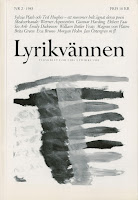I am extremely grateful to Eva Stenskar for sharing the information with me presented in this blog post.
Back in November 2021, Eva wrote to me about an article she read that mentioned two letters from Plath to Siv Arb. This was news! The article, "När Sylvia Plath kom till Sverige" by Anna-Klara Bojö, was published on 8 April 2021, on the Ord & Bild website.
The letters were dated 5 May 1962---just after Arb visited Court Green---and 21 July 1962, just as Plath's marriage was crumbling down. It appears to be a good article (such as is possible to trust the Google translation...for example, "Elm" in Swedish is "Almen" but through Google translate it displays as "General".)
The 5 May 1962 letter was written on the same day Plath wrote to Judith Jones, thanking her belatedly for the first copy she saw of the Knopf edition of The Colossus. In the letter to Arb, Plath enclosed a few poems (no longer with the letter) and mentions by title some of her recent stories. Recent in this instance is a case of semantics as the stories are from 1959. Bojö informed me that Arb's archive, which reportedly is going to the Gothenburg University, does not contain any typescripts.


Ted Hughes has several poems in this issue of Lyrikvännen, too. As well, there are some facsimiles of letters to Arb, and a photograph of him reading papers in the front garden of Court Green with his children in proximity to him.
Did you know... Eva made a comment in one of the monthly Sylvia Plath Society research-sharing meetings (January) that was terrifically interesting. Did you know... that Plath's "Elm" appeared in print for the first time in translation (by Siv Arb) in the Autumn 1962 issue of Rondo, a Swedish journal, before it appeared in print in English (The New Yorker, 3 August 1963). In Rondo, "Elm" appeared along side "Tulips" and "The Colossus".
Thank you Eva and Anna-Klara!
All links accessed 13 February and 1 May 2022.
If you benefited from this post or any content on the Sylvia Plath Info Blog, my website for Sylvia Plath (A celebration, this is), and @sylviaplathinfo on Twitter, then please consider sending me a tip via PayPal. Thank you for at least considering! All funds will be put towards my Sylvia Plath research.
